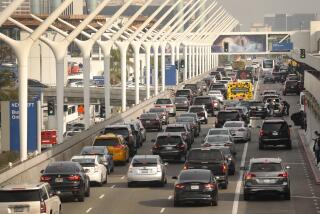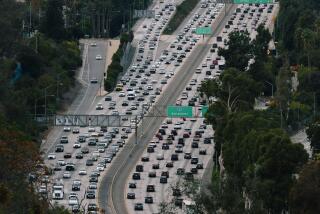The perks of pump avoidance
- Share via
Higher gasoline prices are cleaning out the wallets of motorists, but there may be a silver lining: Traffic is somewhat lighter on the heavily congested freeways and surface streets of Southern California.
It only makes sense that the sharply higher prices at the pump are leading some people to avoid discretionary trips with their cars, carpooling when possible and shifting to public transportation.
Although there are no hard data yet, a broad range of experts say there is evidence that people are buying less gasoline and finding ways to avoid using their cars, contributing to less congestion on the roads.
“We have noticed that volumes are lighter than normal,” said Frank Quon, deputy director of Caltrans freeway operations for Los Angeles County. “We haven’t done a study. But we aren’t experiencing as much congestion, and travel times are shorter.”
Quon said the effect was most likely related to higher gasoline prices and the tail end of spring break in schools, which causes somewhat lighter traffic.
A relatively small change in traffic volume can have a big effect on freeway speeds. That’s because freeway speeds tend to remain stable as volume increases until the point when lanes become saturated. Then speeds drop sharply.
The effect was illustrated in Southern California during the 1984 Summer Olympics, when fewer drivers were on the road.
Meanwhile, Southland public transportation agencies are reporting that ridership has jumped in the first months of 2005 -- up between 3% and 12%, depending on the system.
Anecdotally, a lot of people I talk to say they are seeing the effect every day, which has cut their commute times dramatically. Normally jammed freeways are mysteriously wide open.
If people are indeed cutting back on driving, avoiding discretionary trips, car pooling and using public transportation, it should mean that gasoline sales volumes are dropping.
John Felmy, chief economist at the American Petroleum Institute, the Washington, D.C., trade group that represents the oil industry, says that wholesale deliveries of gasoline across the nation are down slightly.
“Some of the preliminary information we have in the last few weeks indicates that gasoline demand appears to be down a little bit,” Felmy said.
Gasoline prices are up 51 cents a gallon this year across the nation, averaging $2.24 per gallon, Felmy said. That’s a 29% increase in price. California prices are higher, averaging $2.63 a gallon last week.
The prices are obviously going to hurt the people who can least afford it -- lower-income drivers who often drive older, less fuel-efficient cars.
“Millions of American families and small businesses are hurting because of higher gasoline prices,” President Bush acknowledged at his news conference last week.
In the short term, consumers do not significantly change their driving habits when gasoline prices rise. In economic terms, the relationship of prices to sales volume is known as demand elasticity; a 50% increase in price, for example, leads to a 5% drop in demand, according to Felmy.
Using that relationship, the 29% increase in gasoline prices this year should lead to a 2.9% drop in gasoline sales volume. It’s too early to tell, however, whether that has happened.
During the long term, consumers make bigger adjustments, reducing their consumption so much that total spending for gasoline stays flat.
During the energy crisis of the 1970s, consumers made few immediate adjustments, but by the early 1980s they were trading gas guzzlers for fuel-efficient cars.
Another major adjustment is likely these days if gas prices remain high, as most oil experts expect. In the meantime, motorists are getting the benefit of spending somewhat less time on congested freeways.
More to Read
Sign up for Essential California
The most important California stories and recommendations in your inbox every morning.
You may occasionally receive promotional content from the Los Angeles Times.











